Rozhovor / ARISTIDE ANTONAS
Greek withdrawal
Last summer I went to Greece with my friends on vacation. We spent a half of the time exploring Athens and the second half just being a little abandoned on an island, doing nothing altogether. Because of the self-imposed demand for productivity, I was looking for a way to make use of me being physically there. So, I thought of meeting and talking to someone.
At that time, The Supreme Achievement, a catalogue from the workshop organized in 2015 by Campo and Black Square in Rome, lay on my desk and one of the participating architects, Aristide Antonas, was from Greece. I wrote him an e-mail in a little advance, if we could meet in Athens. He was not there, but he suggested that I could reach him in Berlin later. Unfortunately, I was not able to get to Berlin during the rest of the summer for some reason, so we finally agreed on online conversation.

Bloom flying under Lycabettus Hill, printed photo collage, 18x60cm, edition of 5.
Warehouse city
The Supreme Achievement was about re-imagining architecture through constructing fictive cities, referring to 12 Cautionary tales for Christmas by Superstudio from the 1970s, which were ironical commentaries on the society by means of architecture (or its absence). All the collaborators (practicing architects) contributed by their own tales on which the students elaborated later.
The one of Aristide Antonas denounces the agency of architecture in structuring our environment. His tale (Warehouse city) is about a void in the midst of the already built form of a city, inhabited by the community of infrastructure.
What we know as urbanization – “the program for an unlimited extension of networks to a neutral field” – continues on the Internet. This data infrastructure determines, besides functioning of the city, also the new character of its use – participation -, producing participants instead of citizens. What the infrastructure does is dragging the actual city in by its representations, constituting a new city – “an empty space that does not feel empty for its inhabitants.”[1]
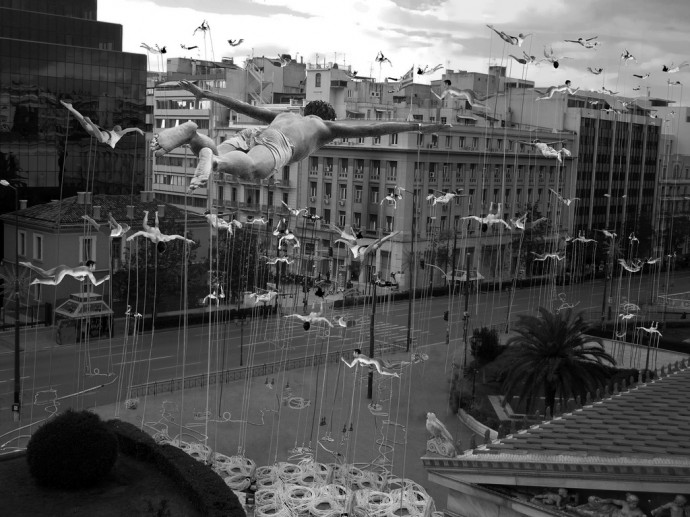
Bloom flying in Athens, printed photo collage, 35x50cm, edition of 5.
Shared Google Docs
Despite, or no matter various circumstances and material factors which led to this conversation, the actual conversation took place on Google Docs spanning over the following period (winter), as it was convenient for both of us – I was in Bratislava and Rome, and Antonas moving between at least Athens, Berlin and London, where he currently teaches Design (Intermediate 14 with Georgios Eftaxiopoulos).
GS: I wanted to meet you in Athens in your studio back then, but you were in Berlin at that time. What is your current setting; since when and why is there this second office in Berlin?
AA: I cannot avoid this question; it comes too often. Of course, I have the luxury of these two places in Athens and Berlin. Since I am an architect, I respect your interest in space, in the space I work in. But it is not so important for me. Or better said, it becomes important, all of a sudden, when the sun is passing through the window, a neighbor is doing something in the opposite building, or when I notice glass cleaning of the tower. When I get distracted, then space becomes important.
I am very careful not to fetishize any of my working conditions as being something worthy of discussion. I can work in coffee-shops, at a common table; temperature is important, the rest is related to an invisible interior space which belongs to me. Becket would describe it better than me. This interior space does not change dramatically, it is always somehow dark and homogeneously unknown. And this does not mean that I immerse myself in my genius; rather the opposite. I am always a bit disgusted with myself; working is not a nice condition. But I never stop working. I never stop working. My life is a ‘no stop studio’[2], working extended everywhere.
An office is a place for thinking and reading. Since I was in Berlin for a longer time, I had had to find such a place. It does not mean that my studio expanded, but my office in Berlin is a good place to think and write about Athens (and other topics), sunny (when there is sun) and noisy. I also like to work in friends’ places. Maria Eichhorn told me she could not work with all this noise I have; her place in Wedding is different, much calmer and neater. I am very interested in her work, and I like her studio very much. I could use it; and I would be very productive in it. Though, I do not think that it is important to compare the work environments of people.
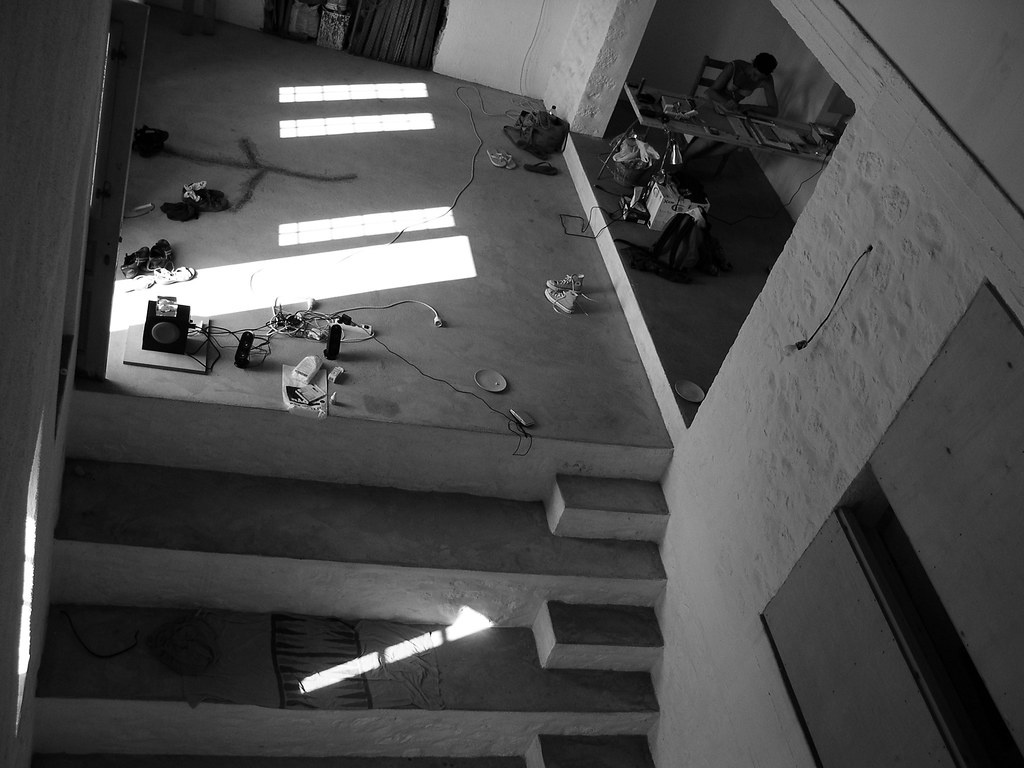
Amphitheater House, Geography of cables, summer 2007 Temporary Installation: electrical equipment and sound system on the floor, shoes, bags, towel, pillows, table, chair, human actor working; photo: author.
You try to avoid stereotypes and to keep yourself in permanent motion, work in motion. I guess, you described a pretty widespread condition of many people. What consequences do you think it has in architecture? What does this mean for the city, not to inhabit one’s own fixed place, but to move around (a city, the world) constantly, changing places (no-stop condition), to be a visitor, a guest, a user?
I do not know what it means yet, but I do work to answer it though. I am not particularly in favor of the culture of production and activation; rather the opposite. I am trying to slow down and understand what the different meanings of “doing nothing” are. How we could restore the power of so many different cultures of apraxia. To use the power of existing.
Heidegger speaks with disrespect about the new worlds of ʻAufenthaltslosigkeitʼ [3], the situations where you cannot stop. He is the bad guy in philosophy, but still I read some of his texts with respect. What you call “a pretty widespread condition” is very close to what he describes as a non-stop changing condition that we watch becoming the norm.
On the other hand, doing nothing is related to understanding of the existing as a field of an intense reference. When speaking of using the power of existing, it is important to know that I see recycling as a cliché. This culture is indeed not an intellectual one. It usually does not investigate the existing, it makes a fetish of it, which leads to a narcissistic exhibition of reuse as fashion. That is a way of killing the power of the existing.
By “being a visitor, a guest, a user”, as you said, we revisit the idea of Oswald Spengler about the decline of the West [4]. We are trying to understand where we are heading after being uprooted from all traditions or after thinking about the roots in a superficial way. Since I work on the move, it affects the type of work that I do. I am always connected to the office, I receive and send things, comment by jpgs of drawings or images. I write and read a lot.
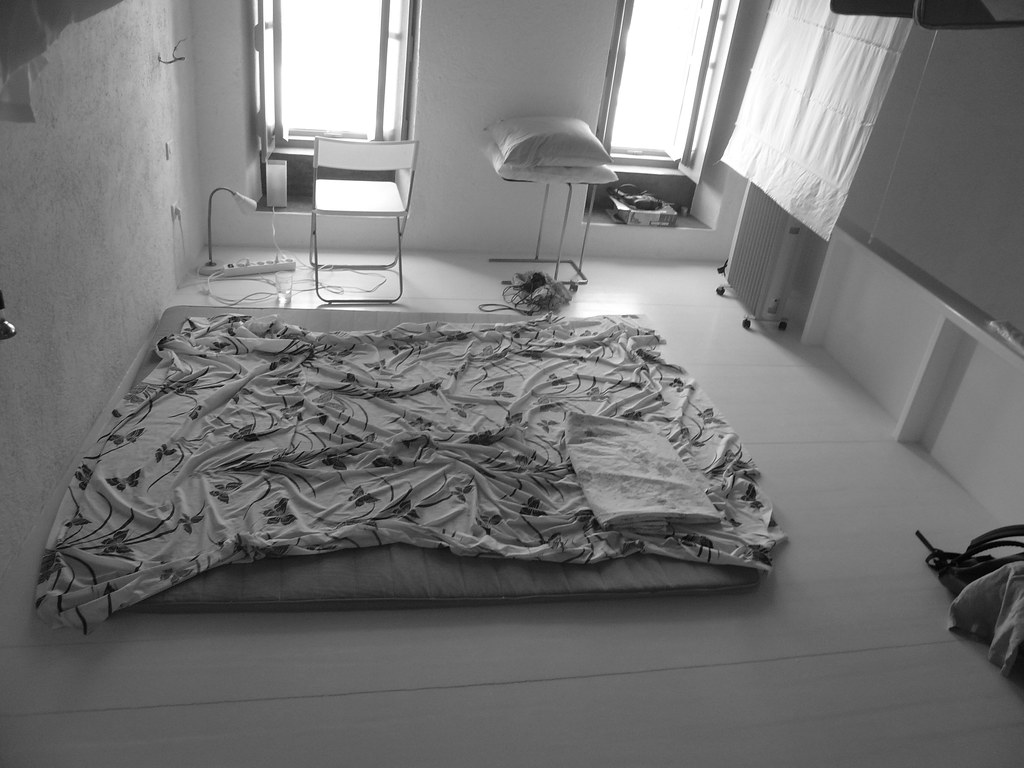
Amphitheater House, The Floor Bed, summer 2017 Temporary Installation: Wooden floor, mattress, white curtain, electrical equipment, chair, radiator; 2,8 x 6,2 x 3 m; photo: author.
Speaking of slowing down and doing nothing, I instantly imagined your project titled House for Doing Nothing which is directly related to Žižek’s quest for withdrawal, in order to take a step back to be able to conduct a critical analysis of a given situation (as opposed to the constant pressure on us to decide). [5]
ʻThe House’ questions the role of architecture as such, since the project is not about specific design or location of the house, which means it is fairly ʽuprooted’. It was meant for escape, but at the same time it shows a paradox of impossibility of doing so. ʻThe Houseʼ rather facilitates a personʼs belonging to some kind of (Internet) community, thus being a representative of our current Internet-contained households which, simultaneously, belong and do not belong to the cities where they are located. Thus, in the end, your ʻHouseʼ calls a possibility of such a withdrawal into question. [6]
This project is meant to somehow criticize this fragment by Žižek. In a way, it seems provocative, but it ends up proposing something like the norm of the today’s condition of everyday life for all of us. Stepping back is what makes the post-network community function today. Žižek proposes to us to withdraw and do nothing but he does not define what is a difference between his concept of doing nothing and what we all already do.
We could also claim that there is a hidden violence in this happy resorting to ʻthe Houseʼ. So, creating a house for Žižek and his withdrawal is meant to remind us what we all want so much when we function as users of networks. We want our bed and do nothing, but at the same time we do idealize a new concept of desert which is to be defined and which represents the post-network city.
Uprootedness is not dramatic anymore, it is a basic conscious condition in which we are in the world. It is so common and banal to be uprooted that the desert condition is not frightening or awakening anymore. This desert is an image of an exotic landscape but it has become our trivial life background. A-demia, the impossibility of ʻdemosʼ (from which demo-cracy comes from), the impossibility of common engagement maybe describes this desert of the public sphere.
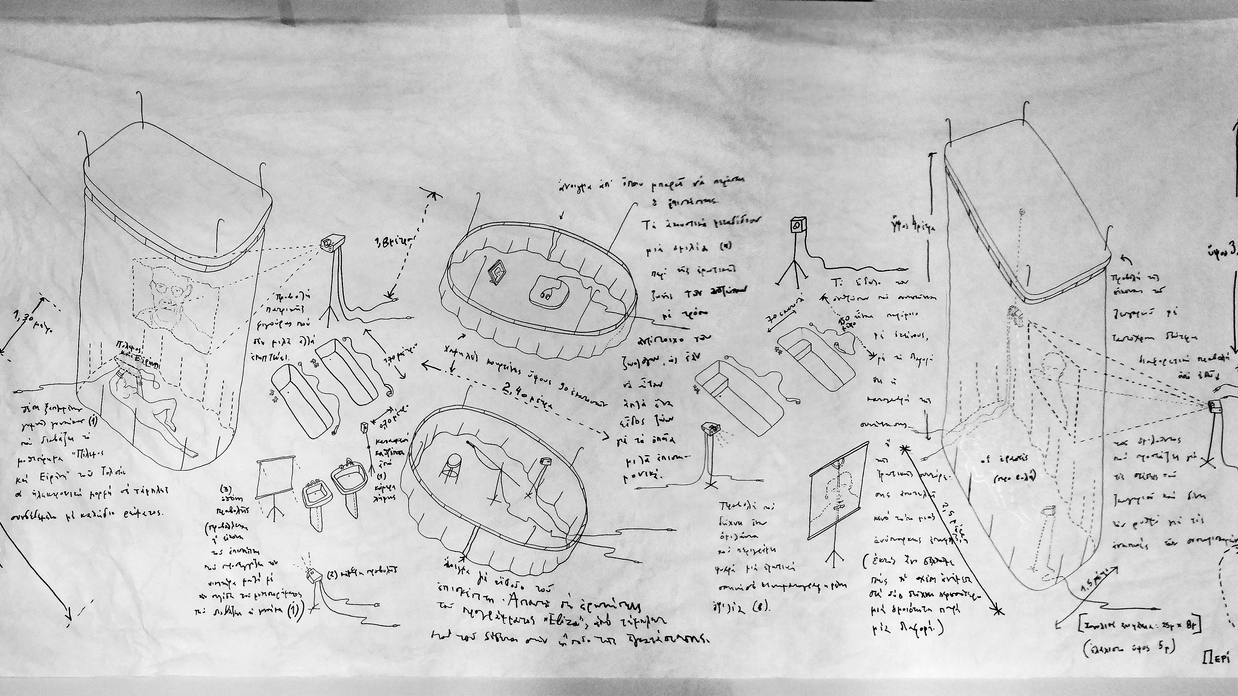
Landscape with curtains and projections, 2018 ink on Tyvek, 300 x 154 cm; courtesy of Aristide Antonas.
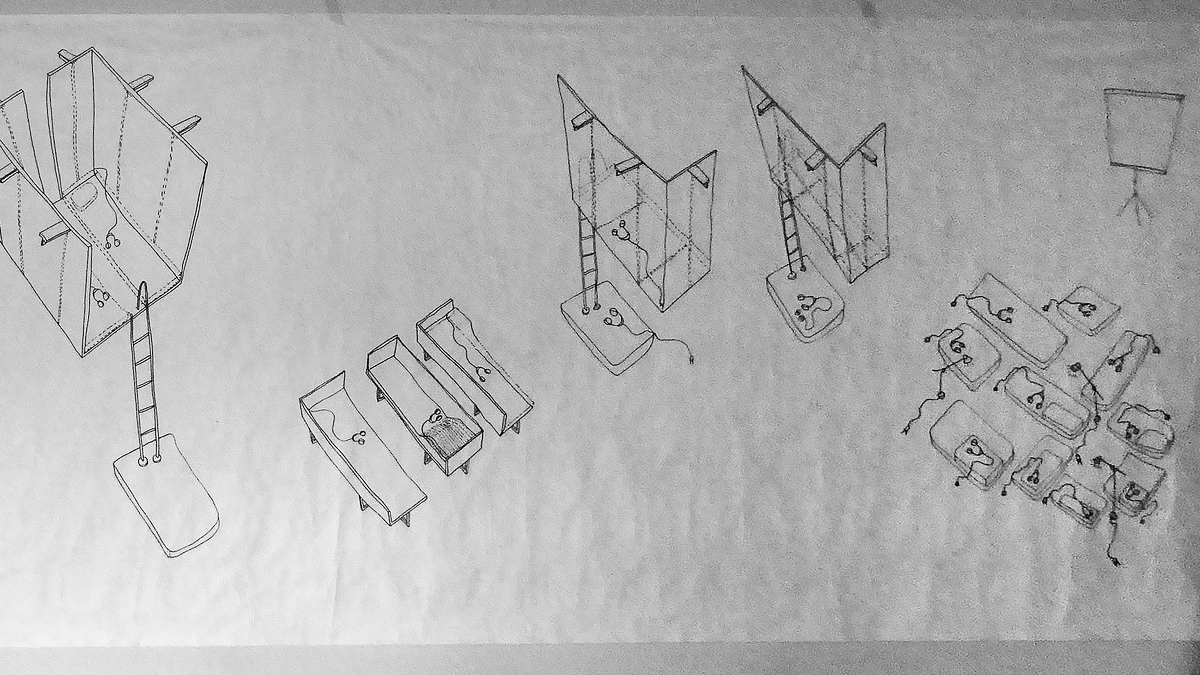
No listener for the headphones, 2018 ink on Tyvek, 230 x 154 cm; courtesy of Aristide Antonas
One of the preconditions to such way of living/working is the access to the Internet: we can move, but we cannot escape. I am not sure if the question makes sense, but how or where are you trying to ʻʼslow down”? Where do you look for “doing nothing” then?
Your question makes a lot of sense to me. It is perhaps one of the most important issues I deal with in my work. I do not blame the condition of doing nothing. I am not scandalized by the specific argument of Žižek; I can also say that this argument could be interesting, if we could distinguish clearly very different types of laziness or apraxia.
I am very suspicious about the concept of withdrawal. In the specific fragment, Žižek neglects the most important paradox of the nowadays‘ domesticity; withdrawal makes the community happen today. We live in a bizzare community constituted by withdrawal. And this is underestimated by him, as if it was unnecessary to mention it. This leads the reader to the same position she or he has been already occupying, but making her or him a hero; the hero of the most common position.
So this is why The House for Doing Nothing has this poisonous side, for which it can be read as a counter project. But there is another side of the project which is more difficult to explain; it deals with the difficulty to organize a necessary distance from this common phenomenon of myself in withdrawal. How can the hero of the most common position leave this usual place?
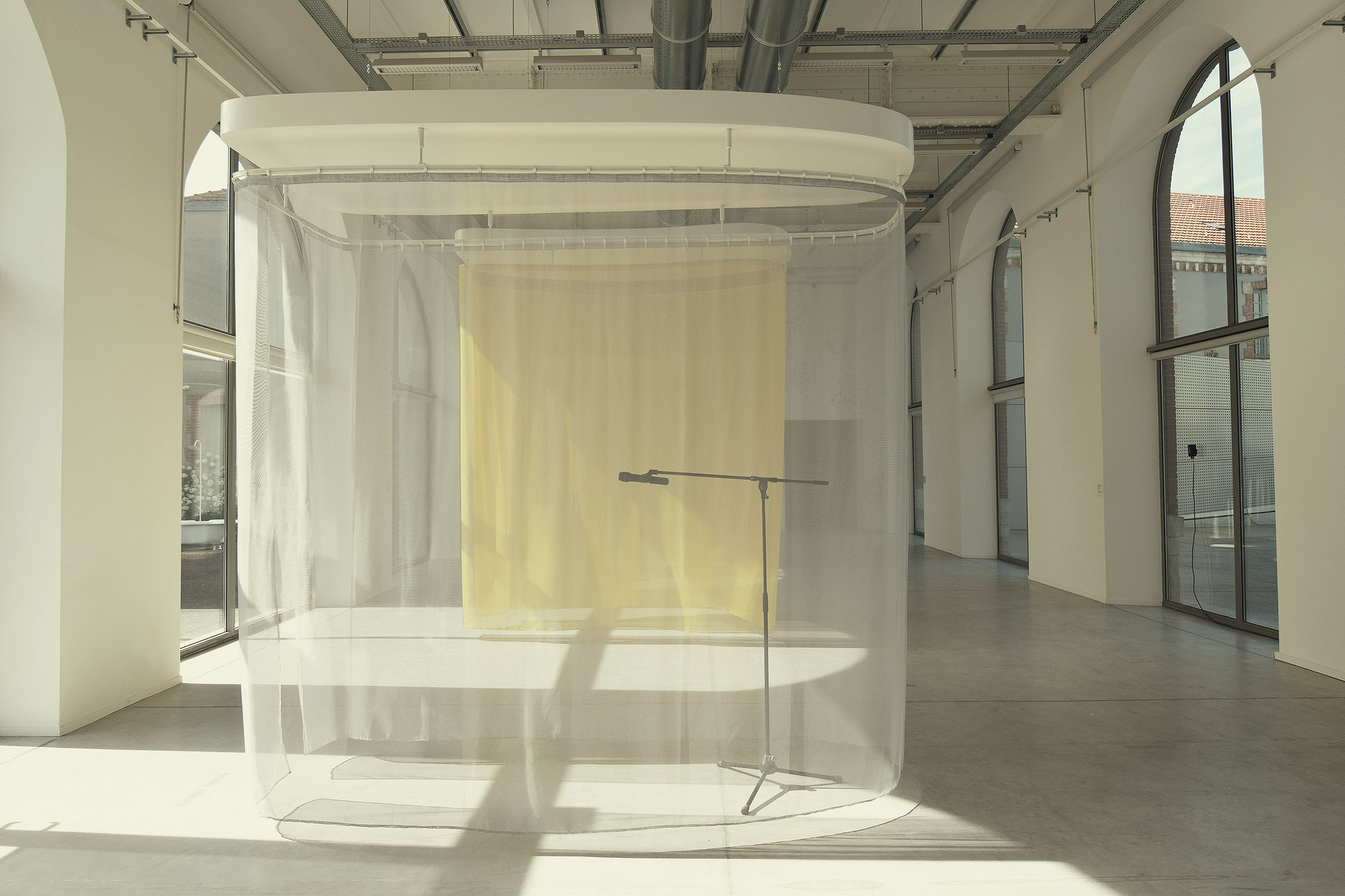
Bed System, detail, 2018; Installation: Wood, semi-transparent curtains, mattresses, headphones, microphone, vocal processor, vibration speakers; Voice: Achille Sauloup, 18,6 x 8,2 x 6 m; Collection Frac Centre-Val de Loire, Orléans.
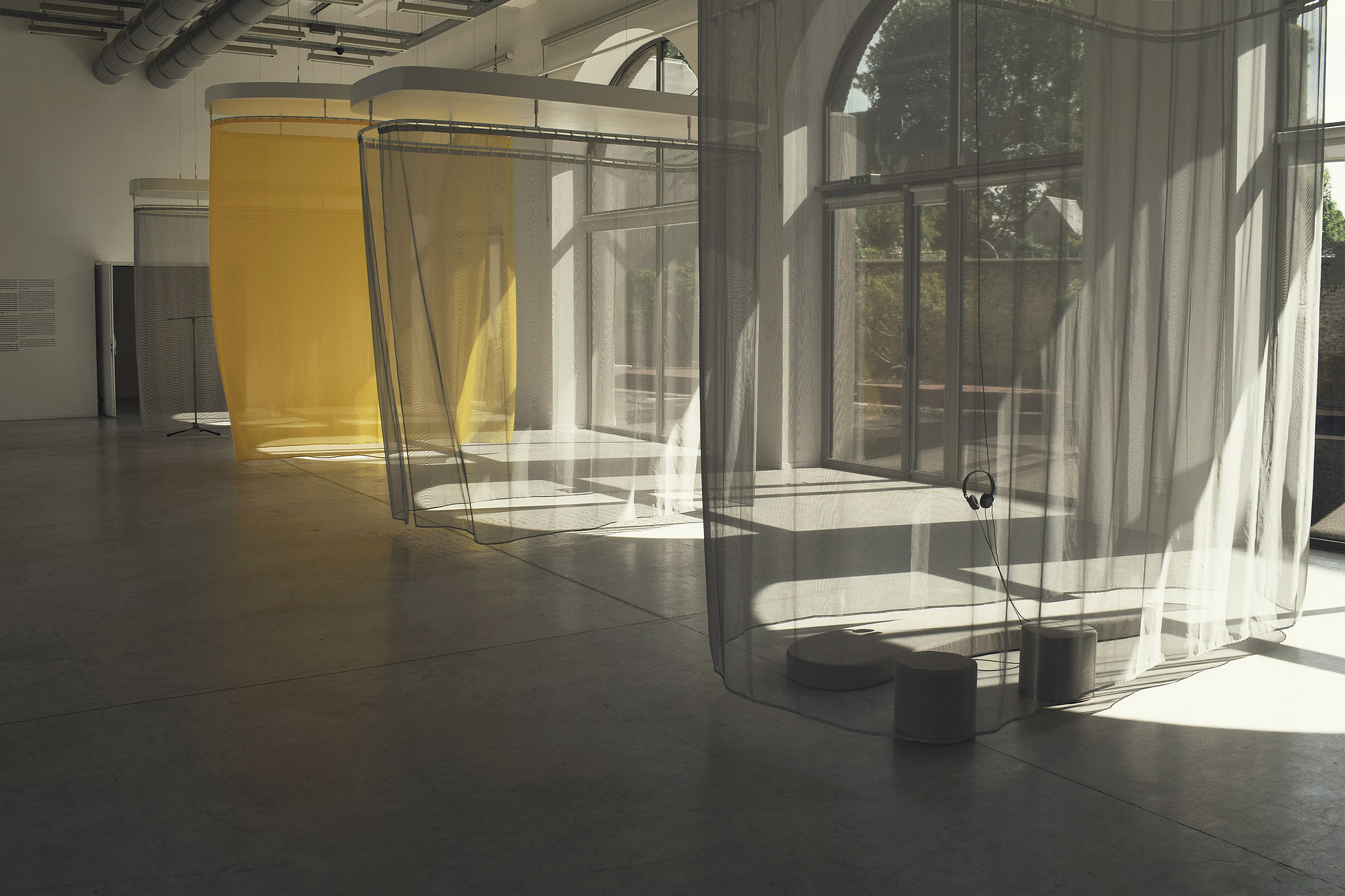
Bed System, 2018; Installation: Wood, semi-transparent curtains, mattresses, headphones, microphone, vocal processor, vibration speakers; Voice: Achille Sauloup 18,6 x 8,2 x 6 m; Collection Frac Centre-Val de Loire, Orléans.
When I get back to what was said earlier, I understand “being a guest, a user, a visitor” in terms of time (its lack) associated with this fetishism and superficiality you mentioned before. In response to that (among other reasons) you are trying to”slow down, and do nothing”. But “being a guest, a user, a visitor” in terms of place more likely refers to that phenomena of “working in constant motion”, which you deliberately practice.
I know, I cannot escape contradictions. I am occupying the same place that I try to criticize, just like all of us do. But describing our position accurately is maybe the most important part of an intellectual work. We are performing this form of life unconsciously. I don’t know anymore what the difference between work and refusal to work or leisure is, but I am not the only one. Are we not tied to a fixed place which is this exact position in front of the infrastructure that structures us as selves? Do we really move? We are taking different updated travels in our own room than the one of Xavier de Maistre.[7]
And from another point of view, yes, I am working in constant motion, but what would be the difference between this “working” and “doing nothing in constant motion”? I mean, why are we moving so much when it is becoming less and less important? And this work I do, this work most of us do, becomes similar to a kind of hypnotic dependence on the infrastructure. Dependance pretty much alike as one we have when getting hypnotically “entertained”.
The gamified labor is a part of this conscious confusion. In its different frames we cannot notice that we work while working; working could be addictive in the same way as a video game is. These new environments for labor that seem to refer so strangely to domestic environment are also indicative of this situation. Being loose, ʻchez-soiʼ is the condition of labor today, at least people have to think they are at home to operate “productively” while laboring. They have to feel like being at home in order to work as expected. Some oppressive working environments can trick us through all kinds of possible scenographies introducing the domestic in the sphere of labor.[8]
The living room is in the background of both, workplaces of today’s immaterial labor and also – this is what makes the contradiction visible – a break room. The working environment merged so abruptly with the one designed for taking a break from it. In a way, the break becomes impossible, but working becomes problematic as well. This has not happened yet, but we see that the tension of the new environments shows us a condition where a bed and a table are in constant fight trying to replace one another. Endless work relates mostly to a working sleep or to a hypnotic kind of labor, but this is already showing a specific way of doing nothing.
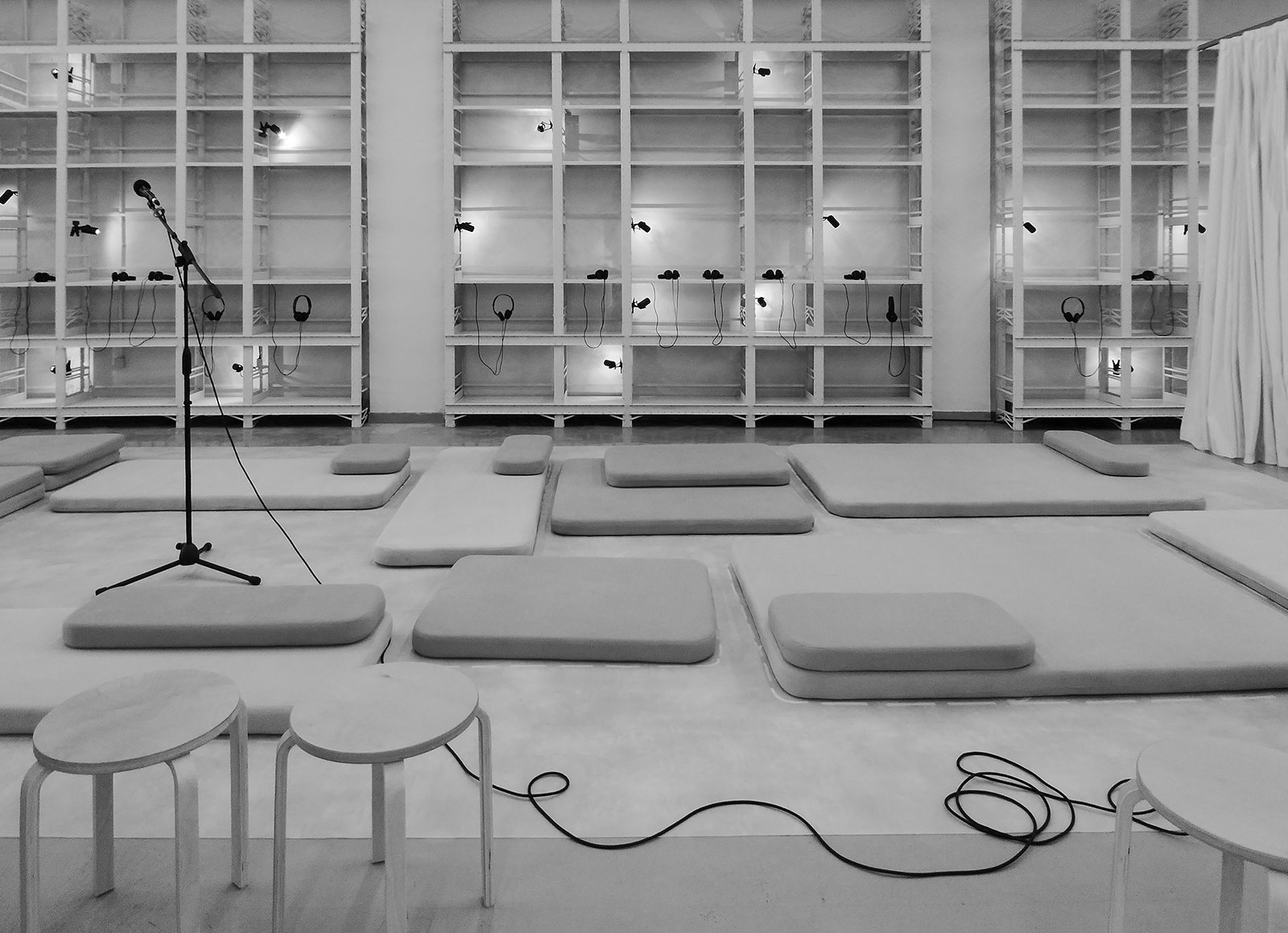
Adventures of Pillows and Mattresses, 2017; Installation: 46 pillows, shelf ensemble, headphones, microphone and stools 20 x 4,5 x 2,5 m; photo: author.
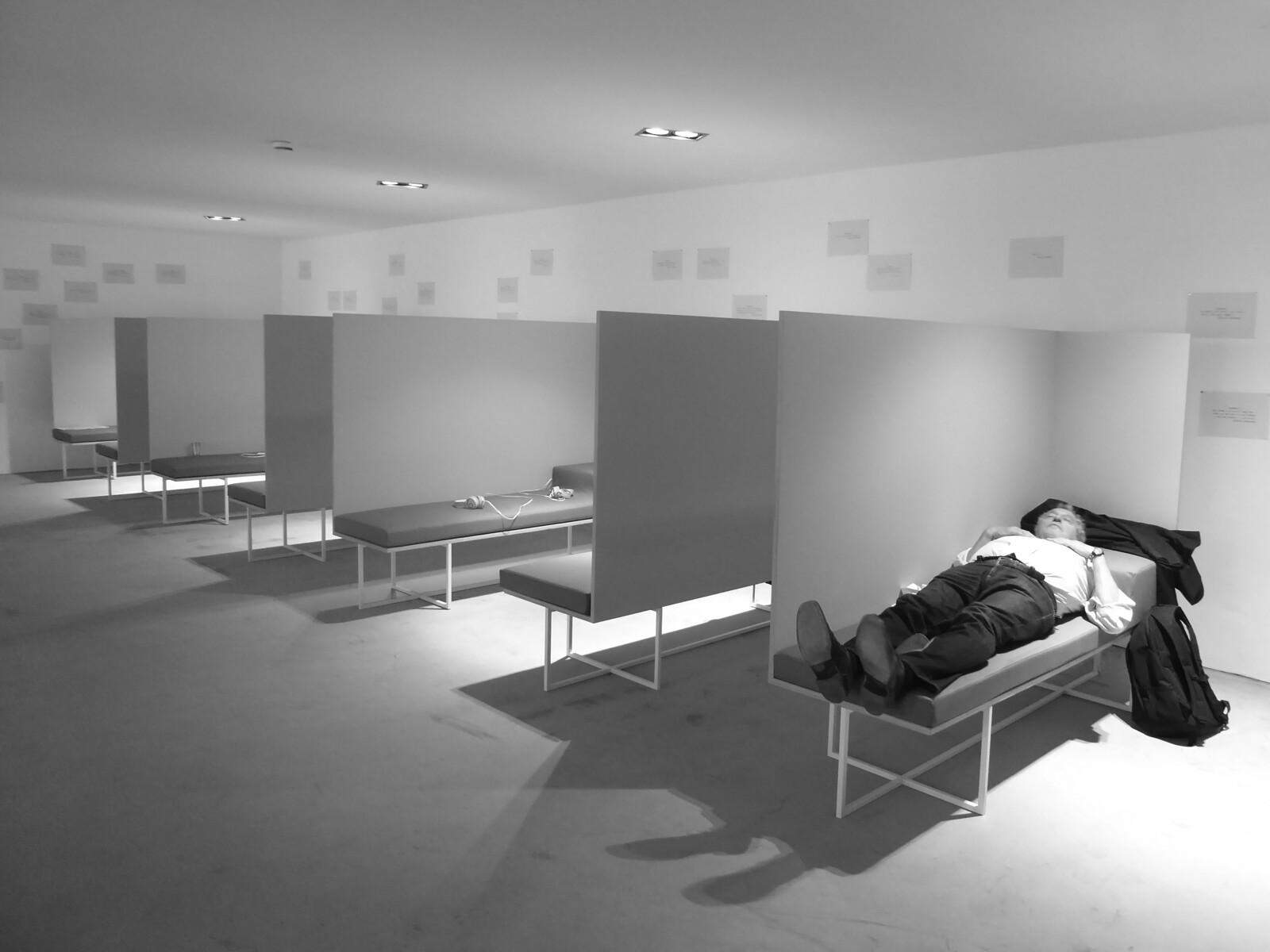
Audio Salon, 2017; Installation: 8 mirroring beds, equipped with headphones; 18 x 2,1 x 1,9 m; photo: author.
When reading last few lines of Antonas‘ response I gradually moved from behind my desk to continue working /doing nothing in my bed.
Wherever, whenever condition
Accepting the dependance of a form of work we do on a situation in which it is done, which was mentioned earlier, I wonder if we can assume similar dependance vice versa. When we work in constant motion, so the form of work is such – texting, commenting, e-mailing, drawing, taking photos etc., then how does the character of the things we actually do, let’s say, on our screens, define the place where we do it?
Home is becoming a working place by virtue of WiFi, meanwhile our workplace becomes our home with all the cosiness, meeting our most banal or intimate needs, anything so you don’t need to go home anymore. Probably, we don’t and won’t live in clear separation between a work place and leisure or domestic one of industrial era anymore. It is getting intermingled (again). There are many things to these phenomena, a few of which Antonas tries to address currently with the Unit he teaches at AA. [9]
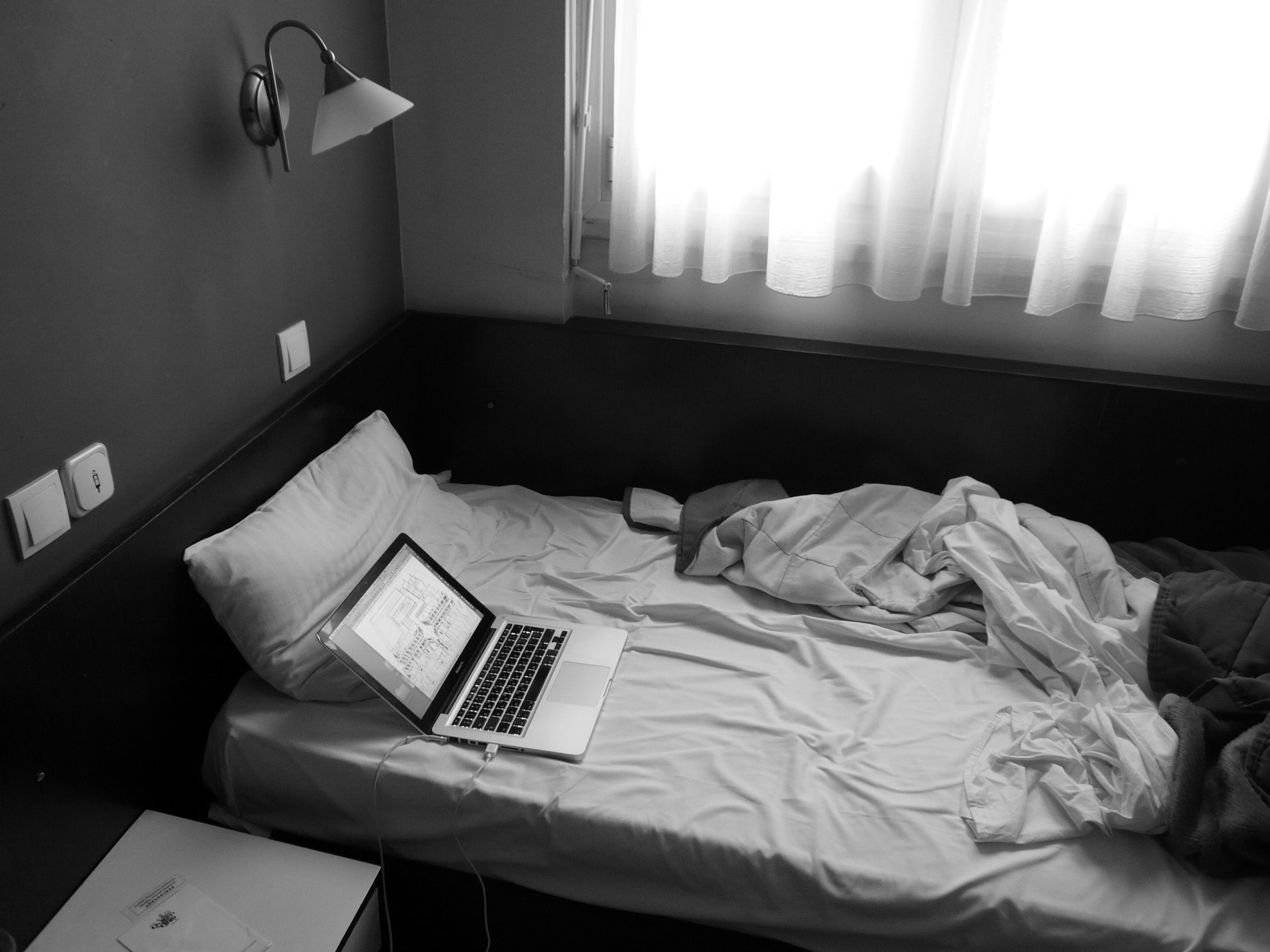
My room, Thessaloniki 2008; Temporary Installation: bed with computer and undone bed sheets, pillow and small table with notes; photo: author.
City of beds
With a bed/table battle he addresses the ongoing structural changes in a broader sense. Through investigation into the imagery of the bed he reflects on the transformation of the modern city – hotelization. This change is ever more present fragmentarization with a room as its constitutive element. Since a room is not completely autonomous entity, it anticipates a modern city´s inherent condition of constant move and temporality – a notion of an urban nomad, of which early and iconic example, claimed by Antonas, is Co-op zimmer by Hannes Meyer (1926).
Co-op zimmer outlines a society where the community is constructed by its uniform, serial needs which are met (and in the same time provoked) by mass-produced, standardized objects. A minimally furnished room dominated by a bed, anticipates its (mutual) dependence on the outside world. Nowadays, a room´s relation with the outside is through digital media. A bed, the room´s foremost representation, has become “a place for the transmission and reception of information, a place of retreat and of active communication”. The private has somehow taken over formation of the public. [10]
Since the Internet is an ultimate heterotopia – reflecting all the real places, dragging them inside by their representations – how is it the other way around? How could it be addressed by architecture? Since changes are so instant, to what extent does it make sense to investigate intersections of these environments (material and virtual one) in deed?
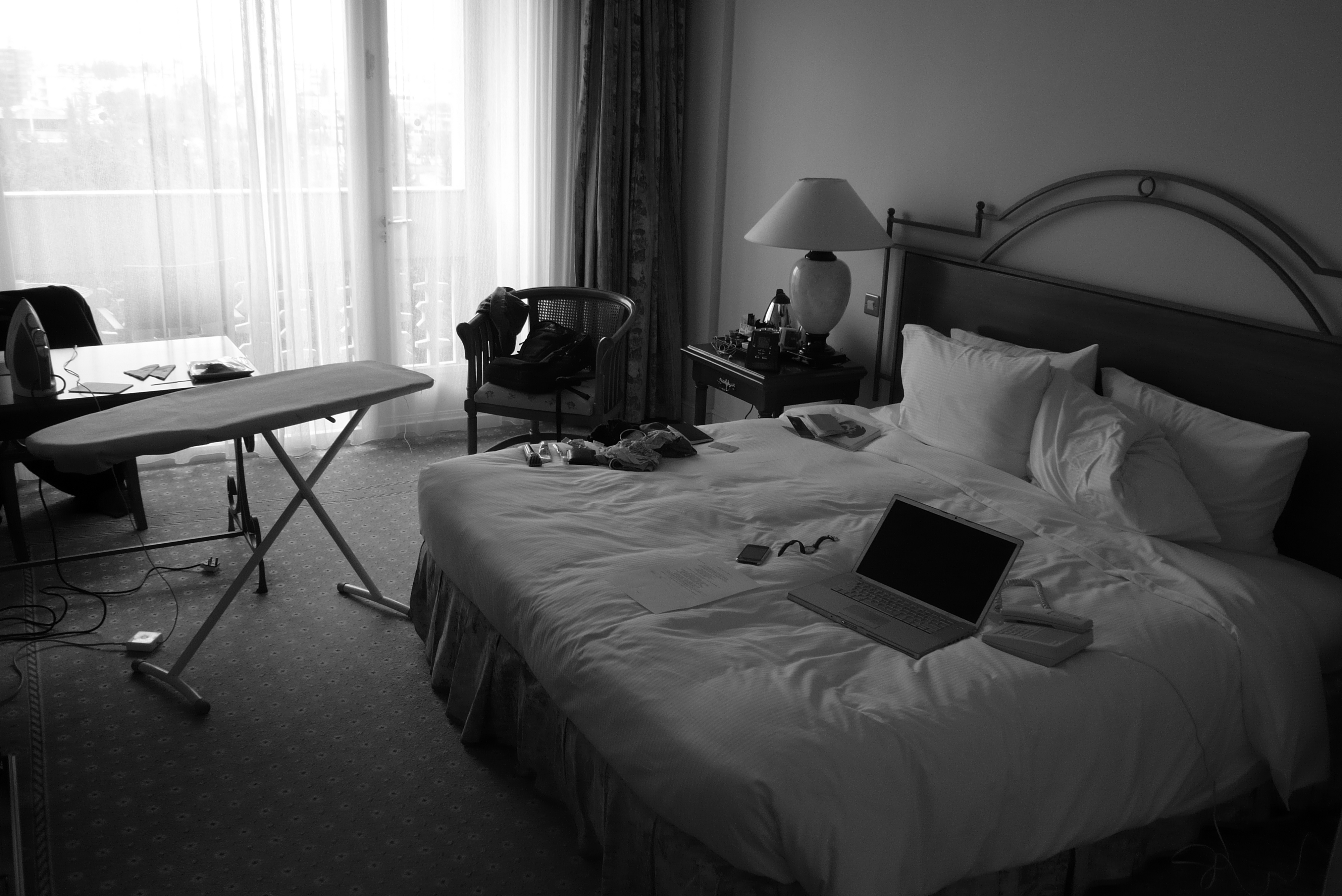
My room, Cyprus 2010; Temporary Installation: undone double bed with computer, telephone, four pillows, table with electric iron, small table with lamp, ironing apparatus; photo: author.
Aristide Antonas is a Greek architect, writer, visual artist. His principal topics of interest are “protocols as architecture”, “infrastructure of the domestic sphere”, “stability from the exaggeration of data flow”; texts combined with traditional design techniques use often references to legislation and archaeology. Antonas holds a PhD in Philosophy from the University of Paris X. He is currently a professor for Design in the Architectural Association in London. He participated in documenta 14 and has had three institutional solo exhibitions on his recent production at the Swiss Architecture Museum, the Vorarlberger Architektur Institut in Austria and the FRAC Centre in Orleans, France.[11]
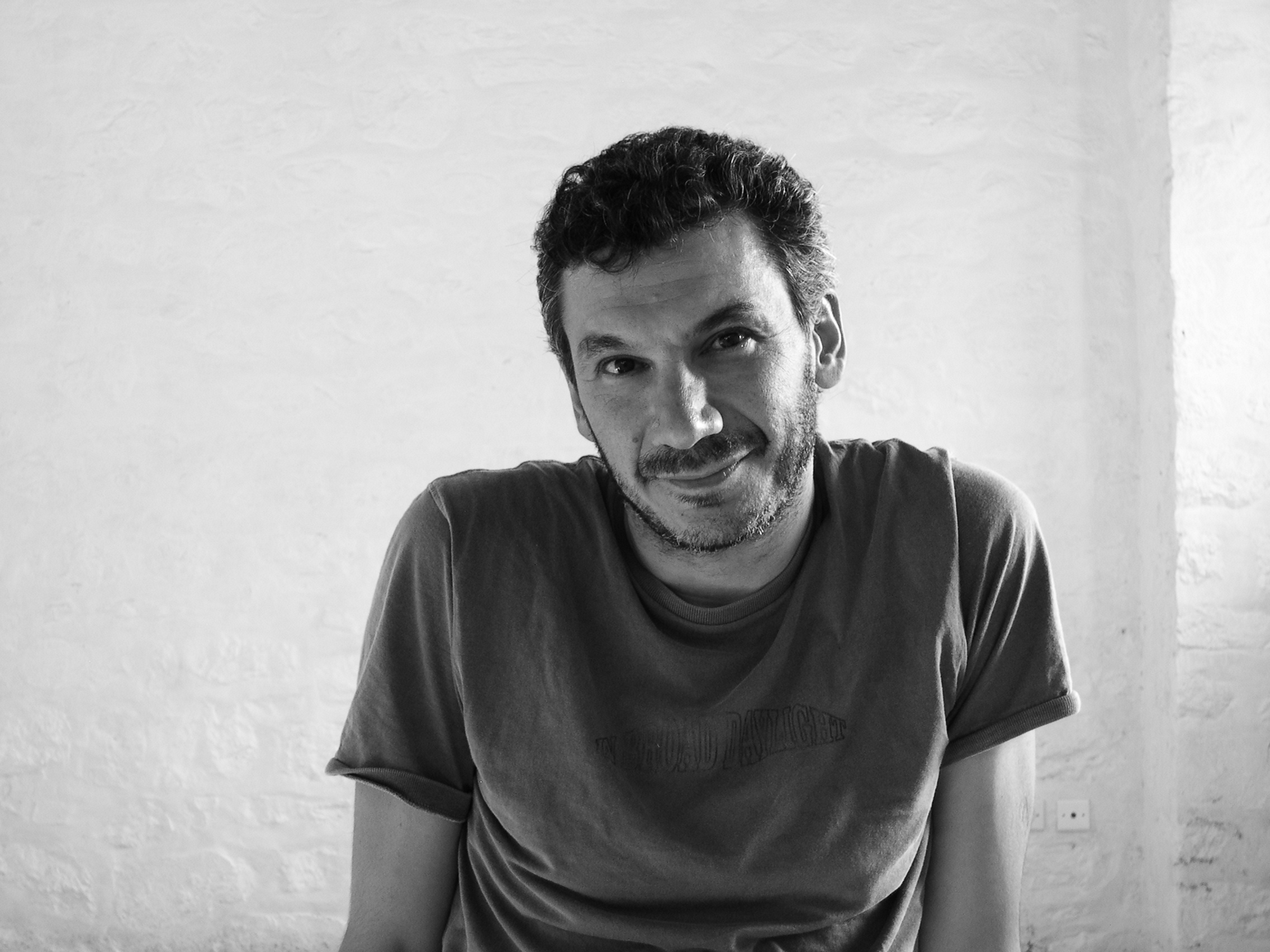
Photo: Elina Axioti.